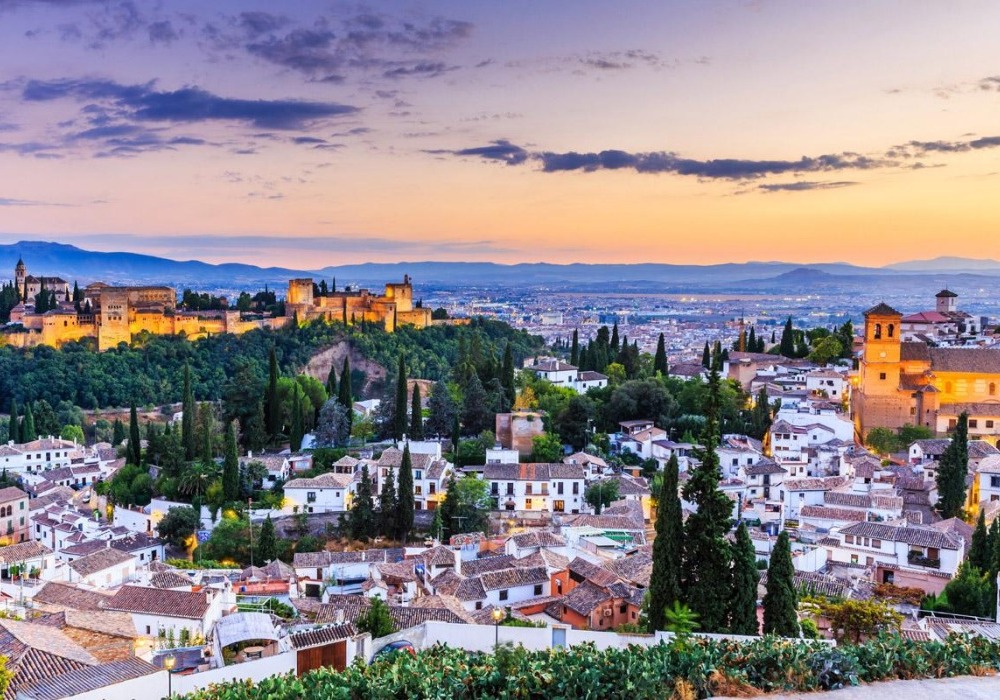Mysterious, mysterious Granada is the dream of romantics and poets. Granada is located in an amazing area, at the foot of the northeastern slope of the Sierra Nevada.
Built on three hills (Albaicin, Sancromonte and Sabica), the city descends gently to a fertile valley, developed by the Moors, where the Hanil River and its tributary Darro flow steadily, and snow-covered peaks sparkle in the distance. According to legend, it was these hills that looked like an open pomegranate that gave the city its name - Granada. Only in this city, landscapes of extraordinary beauty, buildings of ancient architecture and white quarters of new buildings are harmoniously combined in an amazing way. Granada is considered to be one of the most beautiful cities in the world. Life here is measured and unhurried.
On the streets of the city you can still meet pack donkeys accompanied by drovers. White houses and narrow stone-paved streets create an amazing atmosphere of tranquility and solitude.
Eight centuries of Arab influence has left its mark on the architecture of the city, rewarding it with the solitude characteristic of Arab culture.
The fountains of Granada can speak with different voices. And strict and symmetrical courtyards, surrounded by motionless trees, whisper about something mysterious and eternal.
Another tradition that has become part of the everyday life of the inhabitants of Granada is the tradition of tea drinking. And although coffee is now more popular, more and more tea establishments appear here every year. They offer their visitors various types of tea and tinctures, accompanying the meal with oriental rhythms.
Among all the Granada quarters, the old district of Albaicin (Barrio del Albaicín) stands out, recognized as a heritage of mankind in 1984 and located on a hill at the foot of which the Darro River flows. Its narrow streets, paved with stone, still keep the gypsy atmosphere. Not far from it - on the neighboring hill of Sacromonte - there are caves, where on the stage located in the center, you can see gypsy dances - an alternative to Andalusian flamenco.
One of the most striking sights of the city is the luxurious Arab palace of the Alhambra (La Alhambra - 'al Hambra' - in translation means 'red'), which is surrounded by a two-kilometer wall with fortress towers. The main entrance to the palace city is the Gate of Justice. Above the outer arch is a hand, the five fingers of which symbolize the five postulates of Islam. The key above the inner arch is designed to open the gates of heaven. Neighboring - Wine Gate - connects the residential quarter of the city with the Alcazaba.
The oldest part of the Alhambra is a fortress, the construction of which dates back to the 13th century. After the capture of Granada by the Spaniards, by order of King Charles V, most of the buildings were rebuilt. Of the palace buildings from the time of the Arab rulers, only two have survived to this day: the courtyard of the Lions (Patio de los Leones), built during the reign of Muhammad V, and the myrtle courtyard (Patio de los Arrayanes), erected under Yusuf I. On the north side of the palace rises Comares tower, whose external simplicity hides the luxurious interior decoration.
The architecture of this city-palace miraculously intertwined Muslim and Christian cultures, creating an extraordinary palace, striking in its richness and elegance of architectural forms and decor, which today is considered the pearl of Andalusia.
Near the royal palace there is another masterpiece of craftsmanship of architects of the 16th century. - Church of Santa Maria de la Alhambra, which was built on the site of a Muslim mosque that once stood.
In the immediate vicinity of the fortress itself there are two more amazing creations of human hands: the Generalife, the summer residence of the Sultan, where magnificent gardens with fountains are of the greatest interest; and the Palace of Charles V, built in 1526 in the Renaissance style. For its construction, part of the Alhambra had to be sacrificed. This rectangular structure with a circular courtyard was never completed. Today it houses the Museum of Fine Arts and the National Museum of Hispano-Muslim Art.
The Cathedral (Catedral de Granada) is also an important historical and architectural monument of Granada. Its construction began in 1523 in honor of the victory of Catholic Spain over the Arab conquerors. This cathedral was the first temple building in the country, which was built in the Renaissance style, and served as a prototype for most of the temples of Andalusia. Close to the Cathedral, the Royal Chapel (Capilla Real) was built, erected even earlier than the cathedral itself. It contains the tombs of Isabella of Castile and Ferdinand of Aragon.
The popularity of the city is so high that in the summer there is such an unusual phenomenon for Europe as a queue: guests of Granada tend to visit all the local attractions. However, in order to explore the whole city, it is advisable to set aside not one, but several days, or, even better, come to the Costa del Sol more often.





